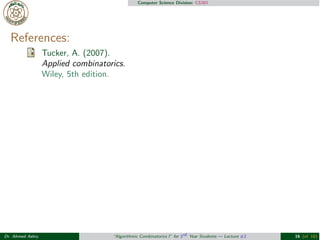Lecture #2: Algorithmic Combinatorics I "#FOSCS301"
- 1. Computer Science Division: CS301 Course CS301, Part: ŌĆ£ALGORITHMIC COMBINATORICS IŌĆØ ( 3rd Year Students ) Prepared by: http://www.researchgate.net/profile/Ahmed_Abdel-Fattah Lecture #2 Dr. Ahmed Ashry ŌĆ£Algorithmic Combinatorics IŌĆØ for 3rd Year Students ŌĆö Lecture #2 1 (of 16)
- 2. Computer Science Division: CS301 The ZEROTH Laws of Counting: The 1st 0th law of counting: The Sum Principle Disjunction leads to addition: add exclusive options. If there are ri different objects in the i th set, for 1 ! i ! m, and if the different m sets are disjoint, then the number of ways to select an object from (one of) the m sets is m !i=1 ri . The 2nd 0th law of counting: The Product Principle Conjunction leads to multiplication: multiply successive choices or actions. For a counting procedure that is decomposable into m successive (ordered) stages, with distinct ri outcomes in the i th stage, for 1 ! i ! m, then the total procedure has m "i=1 ri different composite outcomes, provided that the composite outcomes are all distinct. Dr. Ahmed Ashry ŌĆ£Algorithmic Combinatorics IŌĆØ for 3rd Year Students ŌĆö Lecture #2 2 (of 16)
- 3. Computer Science Division: CS301 The FIRST Laws of Counting: Simple Selections and Arrangements: An r-combination of n distinct objects is an unordered selection of r of the n objects. C(n, r) = n! r! (n ŌłÆ r )! = !n r" An r-permutation of n distinct objects is an arrangement of r out of the n objects. P(n, r) = n! (n ŌłÆ r )! Example: How many 4-digit numbers with distinct digits can be formed from the set of digits {1, 2, 3, 4, 5}? Ans.: Product rule: =" 5 ├Ś 4 ├Ś 3 ├Ś 2 = 120 P(n,r): =" P(5, 4) = 5! (5ŌłÆ4)! = 5! = 120 Dr. Ahmed Ashry ŌĆ£Algorithmic Combinatorics IŌĆØ for 3rd Year Students ŌĆö Lecture #2 3 (of 16)
- 4. Computer Science Division: CS301 Example: Let X = {a, b, c, d}. n = |X| = 4. 1 There are C(4, 2) = 4! 2! 2! = 6 ways to select 2 letters from X. {a, b} {a, c} {a, d} {b, c} {b, d} {c, d} 2 If these letters form a string, we have P(4, 2) = 4! (4ŌłÆ2)! = 12 ways. (a, b) (a, c) (a, d) (b, a) (b, c) (b, d) (c, a) (c, b) (c, d) (d, a) (d, b) (d, c) To form a string of length 2, we first select any 2 letters from X in C(4, 2) ways, then arrange these letters among themselves in 2! ways. Applying the product rule, we can see that P(4, 2) = C(4, 2) ├Ś 2!. Dr. Ahmed Ashry ŌĆ£Algorithmic Combinatorics IŌĆØ for 3rd Year Students ŌĆö Lecture #2 4 (of 16)
- 5. Computer Science Division: CS301 Permutations of Non-Distinct Objects: Theorem (The Mississippi Rule:a) a([Tucker, 2007, Theorem 1, Page 187]) The number of permutations of n objects that consist of qi objects of the i th type, for 1 ! i ! t, i.e. n = t ! i=1 qi, is given by: P(n; q1, q2, . . . , qt) := n! q1! ├Ś q2! ├Ś ┬Ę┬Ę ┬Ę├Śqt ! In how many ways can we arrange 3 dashes and 2 dots? (Ans.) In P(5; 3, 2) = (3 + 2)! 3! ├Ś 2! = 10 ways (N.B. n = 5, q1 = 3, and q2 = 2). What is the number of distinct permutations of ŌĆ£MISSISSIPPIŌĆØ? (Ans.) In P(11; 1, 4, 4, 2) = 11! 4! ├Ś 4! ├Ś 2! = 34, 650 ways (N.B. n = 11, qM = 1, qI = 4, qS = 4, and qP = 2). Dr. Ahmed Ashry ŌĆ£Algorithmic Combinatorics IŌĆØ for 3rd Year Students ŌĆö Lecture #2 5 (of 16)
- 6. Computer Science Division: CS301 Digression: Deal or No Deal? Want to get your 6% of oral examination? Here is the deal: 1 Form a team of 2 students [use: #FOSCS301 Team] 2 Select a (predefined) topic. 3 Take your time. 4 Prepare and present in (max.) 5 minutes/slides. N.B. Only 13 topics. . . First come first served! Dr. Ahmed Ashry ŌĆ£Algorithmic Combinatorics IŌĆØ for 3rd Year Students ŌĆö Lecture #2 6 (of 16)
- 7. Computer Science Division: CS301 Digression: Coding Things WhatŌĆÖs an Octet? An octeta is a unit of digital information in computing and telecommunications that consists of eight bits. The term is often used when the term byte might be ambiguous, as historically there was no standard definition for the size of the byte. a(Source: http://en.wikipedia.org/wiki/Octet_(computing)) Dr. Ahmed Ashry ŌĆ£Algorithmic Combinatorics IŌĆØ for 3rd Year Students ŌĆö Lecture #2 7 (of 16)
- 8. Computer Science Division: CS301 Example: We have 5 English books, 7 French, and 6 German books. 1 How many ways are there to choose two books? 2 How many ways are there to choose two books of different languages? Hints: Here, n = 5+7+6 = 18. 2!├Ś16! = 18├Ś17 2 = 9├Ś 17 ways. 1 C(n, r) = C(18, 2) = 18! 2 We may want to divide the problem, depending on the language of the two selected different books, to the following subproblems: 1 The 2 books are English and French: 5 ├Ś7 = 35 ways 2 The 2 books are English and German: 5 ├Ś6 = 30 ways 3 The 2 books are French and German: 7 ├Ś6 = 42 ways Using the ŌĆ£sum principleŌĆØ, we have a total of 35 + 30 + 42 ways. Dr. Ahmed Ashry ŌĆ£Algorithmic Combinatorics IŌĆØ for 3rd Year Students ŌĆö Lecture #2 8 (of 16)
- 9. Computer Science Division: CS301 Group Formation: Given 7 women and 4 men, how many ways to form a committee: (a) of 5 people, which has 3 women and 2 men? (b) of any size, which has equal numbers of women and men? (c) of 4 people, which has at least 2 women? (d) of 4 people, one of them must be Mr. Abdou? Dr. Ahmed Ashry ŌĆ£Algorithmic Combinatorics IŌĆØ for 3rd Year Students ŌĆö Lecture #2 9 (of 16)
- 10. Computer Science Division: CS301 Committee Formation: Given 7 women and 4 men, how many ways to form a committee: (a) of 5 people, which has 3 women and 2 men? Answer: (a) Select 3 women and 2 men in #7 3$ and #4 2$, respectively, then apply the product rule. Dr. Ahmed Ashry ŌĆ£Algorithmic Combinatorics IŌĆØ for 3rd Year Students ŌĆö Lecture #2 10 (of 16)
- 11. Computer Science Division: CS301 Committee Formation: Given 7 women and 4 men, how many ways to form a committee: (b) of any size, which has equal numbers of women and men? Answer: (b) Possible sizes are 1, 2, 3, and 4. Answer: 4 !i=1 %7 i& ├Ś %4 i&. Dr. Ahmed Ashry ŌĆ£Algorithmic Combinatorics IŌĆØ for 3rd Year Students ŌĆö Lecture #2 10 (of 16)
- 12. Computer Science Division: CS301 Committee Formation: Given 7 women and 4 men, how many ways to form a committee: (c) of 4 people, which has at least 2 women? Answer: (c) We have 3 subcases: %7 2& ├Ś %4 2& + %7 3& ├Ś %4 1& + %7 4& Dr. Ahmed Ashry ŌĆ£Algorithmic Combinatorics IŌĆØ for 3rd Year Students ŌĆö Lecture #2 10 (of 16)
- 13. Computer Science Division: CS301 Committee Formation: Given 7 women and 4 men, how many ways to form a committee: (d) of 4 people, one of them must be Mr. Abdou? Answer: (d) Pick any 3 other people from the remaining 10 in #10 3 $ ways. Dr. Ahmed Ashry ŌĆ£Algorithmic Combinatorics IŌĆØ for 3rd Year Students ŌĆö Lecture #2 10 (of 16)
- 14. Computer Science Division: CS301 In how many ways can n people be seated: 1 in a row? 2 in a circular ring? 1 n! ways. 2 There can be at least two ways to look at the circular case: 1 LetŌĆÖs pick any one person to occupy any fixed position. The remaining n ŌłÆ 1 people are arranged relative to the fixed position in (n ŌłÆ 1)! ways. 2 First, arrange the n people linearly in n! ways. For each way, close the two ends of the line to form a circle. Of these n! circles, circular arrangements are similar (i.e. obtained in the same manner) if one can be obtained from another by rotation of one, two, . . . , or n positions. This means there are P(n,n) n = n! n = (n ŌłÆ 1)! ways. Dr. Ahmed Ashry ŌĆ£Algorithmic Combinatorics IŌĆØ for 3rd Year Students ŌĆö Lecture #2 11 (of 16)
- 15. Computer Science Division: CS301 How many ways can 8 people sit in a circle if Omar and Salwa must sit next to each other? Hints: Method 1: 1 Treat Omar and Salwa as a single unit, then arrange 7 units in a circle (6! ways). 2 There are 2 ways to place Omar and Salwa next to each other. 3 Final answer: 6! ├Ś 2 = 1440 ways. Method 2: 1 Seat Omar anywhere. 2 Seat Salwa adjacent to him (i.e. 2 ways). 3 Pick the remaining 6 people one at a time: 6 ├Ś 5 ├Ś 4 ├Ś 3 ├Ś 2 ├Ś 1. 4 Final answer: 2 ├Ś 6 ├Ś 5 ├Ś 4 ├Ś 3 ├Ś 2 ├Ś1 = 1440 ways. Exercise: What is the number of ways if Omar and Salwa refuse to sit next to each other? Dr. Ahmed Ashry ŌĆ£Algorithmic Combinatorics IŌĆØ for 3rd Year Students ŌĆö Lecture #2 12 (of 16)
- 16. Computer Science Division: CS301 Combinatorial Arguments: Example 1: Give a combinatorial argument to prove that P(n, r) = C(n, r ) ├Ś r !. Solution: The LHS is P(n, r ). This gives the number of ways to arrange r objects of n distinct objects. Which can be done in another way: Select r objects from the n distinct objects (in C(n , r ) ways), Then arrange them in r ! ways, Then apply the product rule to get C(n , r ) ├Ś r !. Therefore, LHS=RHS Dr. Ahmed Ashry ŌĆ£Algorithmic Combinatorics IŌĆØ for 3rd Year Students ŌĆö Lecture #2 13 (of 16)
- 17. Computer Science Division: CS301 Combinatorial Arguments: Example 2: Give a combinatorial argument to prove that C(n, r) = C(n, n ŌłÆ r ). Solution: The LHS gives the number of ways to form a subset of r objects of n distinct objects. This can be done in another way: Select (n ŌłÆ r ) objects from the n distinct objects (in C(n , n ŌłÆ r ) ways), and exclude them. The number of ways to construct a subset of r objects is equal to the number of ways to select (n ŌłÆ r ) objects NOT to be included. Therefore, LHS=RHS Dr. Ahmed Ashry ŌĆ£Algorithmic Combinatorics IŌĆØ for 3rd Year Students ŌĆö Lecture #2 14 (of 16)
- 18. Computer Science Division: CS301 Take Home Messages: 1 Bad news first: ŌĆ£Nothing alone is enoughŌĆØ 2 Divide and conquer: With Practice Comes Mastery! Homework #2: 1 Apply the Mississippi Rule to prove that (3n)! is divisible by 2n ├Ś 3n. [Hint: think about permuting 3n non-distinct objects of n types] 2 Read and understand Example 4 ([Tucker, 2007, Page 175]). 3 Read and understand Example 6 ([Tucker, 2007, Page 176]). 4 Solve Exercises 11 ([Tucker, 2007, Page 181]). Dr. Ahmed Ashry ŌĆ£Algorithmic Combinatorics IŌĆØ for 3rd Year Students ŌĆö Lecture #2 15 (of 16)
- 19. Computer Science Division: CS301 References: Tucker, A. (2007). Applied combinatorics. Wiley, 5th edition. Dr. Ahmed Ashry ŌĆ£Algorithmic Combinatorics IŌĆØ for 3rd Year Students ŌĆö Lecture #2 16 (of 16)

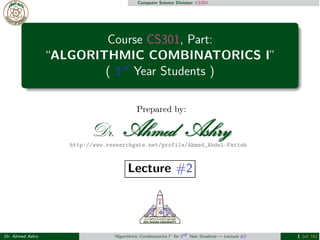
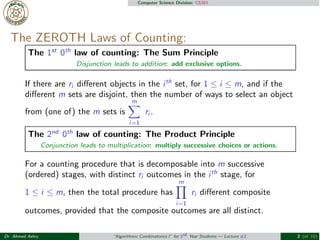

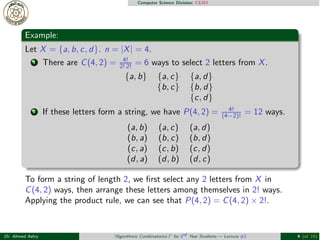
![Computer Science Division: CS301
Permutations of Non-Distinct Objects:
Theorem (The Mississippi Rule:a)
a([Tucker, 2007, Theorem 1, Page 187])
The number of permutations of n objects that consist of qi objects of the i th type,
for 1 ! i ! t, i.e. n =
t
!
i=1
qi, is given by:
P(n; q1, q2, . . . , qt) :=
n!
q1! ├Ś q2! ├Ś ┬Ę┬Ę ┬Ę├Śqt !
In how many ways can we arrange 3 dashes and 2 dots?
(Ans.) In P(5; 3, 2) =
(3 + 2)!
3! ├Ś 2!
= 10 ways (N.B. n = 5, q1 = 3, and q2 = 2).
What is the number of distinct permutations of ŌĆ£MISSISSIPPIŌĆØ?
(Ans.) In P(11; 1, 4, 4, 2) =
11!
4! ├Ś 4! ├Ś 2!
= 34, 650 ways (N.B. n = 11, qM = 1, qI = 4, qS = 4,
and qP = 2).
Dr. Ahmed Ashry ŌĆ£Algorithmic Combinatorics IŌĆØ for 3rd Year Students ŌĆö Lecture #2 5 (of 16)](https://image.slidesharecdn.com/lex2-libre-141030221821-conversion-gate02/85/Lecture-2-Algorithmic-Combinatorics-I-FOSCS301-5-320.jpg)
![Computer Science Division: CS301
Digression: Deal or No Deal?
Want to get your 6% of oral examination?
Here is the deal:
1 Form a team of 2 students [use: #FOSCS301 Team]
2 Select a (predefined) topic.
3 Take your time.
4 Prepare and present in (max.) 5 minutes/slides.
N.B. Only 13 topics. . . First come first served!
Dr. Ahmed Ashry ŌĆ£Algorithmic Combinatorics IŌĆØ for 3rd Year Students ŌĆö Lecture #2 6 (of 16)](https://image.slidesharecdn.com/lex2-libre-141030221821-conversion-gate02/85/Lecture-2-Algorithmic-Combinatorics-I-FOSCS301-6-320.jpg)
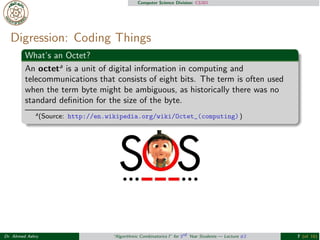
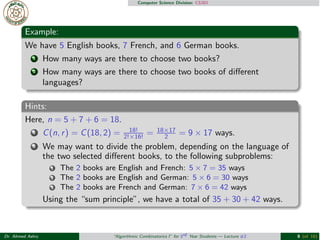
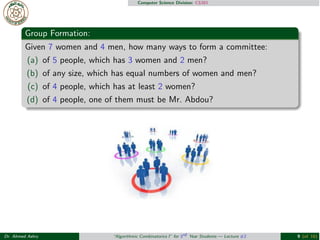
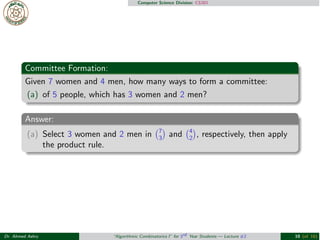
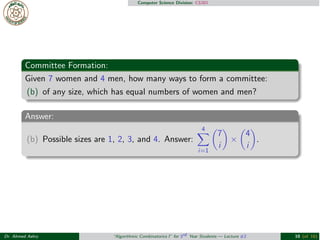
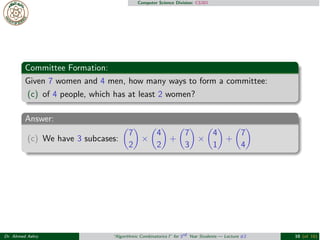
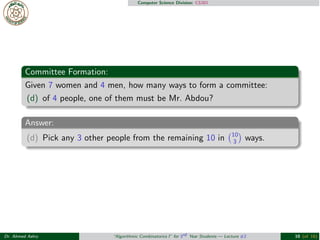
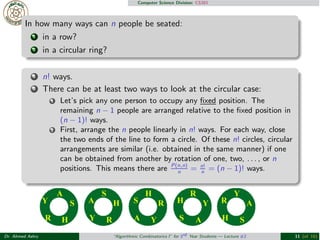
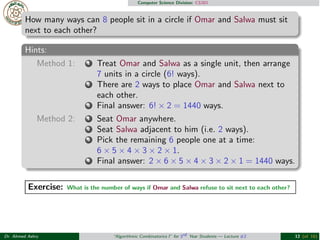
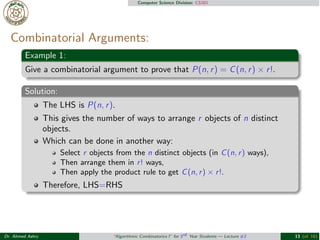
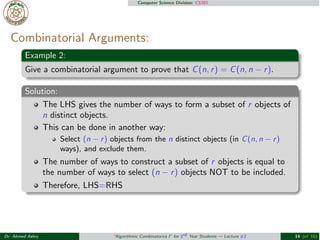
![Computer Science Division: CS301
Take Home Messages:
1 Bad news first: ŌĆ£Nothing alone is enoughŌĆØ
2 Divide and conquer: With Practice Comes
Mastery!
Homework #2:
1 Apply the Mississippi Rule to prove that (3n)! is divisible by 2n ├Ś 3n.
[Hint: think about permuting 3n non-distinct objects of n types]
2 Read and understand Example 4 ([Tucker, 2007, Page 175]).
3 Read and understand Example 6 ([Tucker, 2007, Page 176]).
4 Solve Exercises 11 ([Tucker, 2007, Page 181]).
Dr. Ahmed Ashry ŌĆ£Algorithmic Combinatorics IŌĆØ for 3rd Year Students ŌĆö Lecture #2 15 (of 16)](https://image.slidesharecdn.com/lex2-libre-141030221821-conversion-gate02/85/Lecture-2-Algorithmic-Combinatorics-I-FOSCS301-18-320.jpg)
